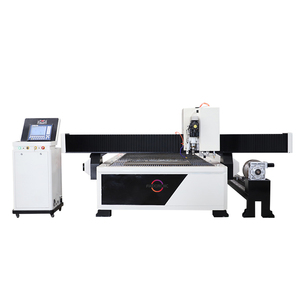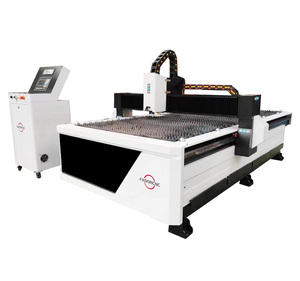
All categories
Featured selections
Trade Assurance
Buyer Central
Help Center
Get the app
Become a supplier

(1616 products available)




















The CNC plasma profile cutter is a type of industrial machinery that uses a high-velocity jet of ionized gas to cut through electrically conductive materials with great precision. There are different types of CNC plasma cutters available in the market to meet various industrial cutting needs.
Portable CNC plasma cutters allow operators to move the cutter to different locations easily. They are suitable for on-site cutting tasks and offer flexibility for businesses that need to cut materials in various locations. Portable CNC plasma cutters typically come with lightweight construction and ergonomic designs, making them easy to use and transport.
Similar to portable cutters, benchtop CNC plasma cutters are designed to be placed on a workbench or table for cutting operations. They are ideal for small workshops or facilities with limited floor space. Benchtop plasma cutters offer a compact and space-saving solution while providing precise cutting capabilities.
High-definition CNC plasma cutters are equipped with advanced plasma torches and control systems to achieve high-precision cutting. They are capable of producing clean cuts with smooth edges on various types of materials. High-definition plasma cutters are suitable for industries that require intricate detailing and high-quality finish.
Multi-process CNC plasma cutters are integrated with multiple cutting technologies, such as plasma and oxy-fuel cutting. They offer versatility in handling different types of materials and thicknesses. Multi-process plasma cutters can adapt to varying cutting requirements within a single machine, streamlining the production process.
Large-format CNC plasma cutters are designed for cutting oversized or heavy-duty materials. They feature extended cutting tables and powerful plasma systems to accommodate large workpieces. Large-format plasma cutters are commonly used in industries like construction, metal fabrication, and shipbuilding that require cutting of substantial plates or sheets.
The specifications of a CNC plasma profile cutter are subject to the type and model of the machine in use. The following are some of the most common CNC plasma profile cutter specifications that business buyers should familiarize themselves with.
The cutting capacity of a CNC plasma profile cutter is typically indicated in terms of maximum thickness and the maximum size of the workpiece it can handle. This varies depending on the type and model of the machine. For instance, some CNC plasma cutters can handle materials of up to 150 mm, while others are designed to deal with materials of up to 200 mm.
CNC plasma profile cutters are known for their high precision. The cutting precision is often measured by factors such as the cutting speed, positional accuracy, and repeatability. The cutting speed of a CNC plasma profile cutter varies depending on the thickness and material of the workpiece. The repeatability of the cutter is usually within a few thousandths of an inch, ensuring consistent and precise cuts throughout the production process.
The size of the work table of a CNC plasma profile cutter varies depending on the model and design. The table size is an important specification to look at because it determines the maximum size of the workpiece that can be accommodated and the amount of working area available.
The consumables of a CNC plasma profile cutter are the nozzles, electrodes, and shields, among others. These components wear out over time and are subject to regular replacement and maintenance to ensure optimal cutting performance. Depending on the model and brand of the machine in use, the replacement requirements for these parts can vary.
Proper maintenance of a CNC plasma profile cutter is essential for ensuring optimal performance and longevity of the machine. Regardless of the model or type of plasma cutter, here are some maintenance tips to keep in mind.
These are just some of the basic maintenance tips for a CNC plasma profile cutter. Depending on the specific model or brand, users may need to perform additional maintenance steps.
CNC plasma profile cutters are widely used in various industries and fields.
Metal fabrication workshops and factories use CNC plasma profile cutters to cut a wide range of metal materials, such as steel, aluminum, and copper. They can produce various products, including metal plates, frames, components, etc.
CNC plasma cutters are widely used in the automotive industry for cutting various automotive components, such as chassis, body panels, exhaust systems, etc. Using CNC plasma cutters to cut automotive parts can achieve precise cutting and high production efficiency.
In the construction industry, CNC plasma profile cutters can be used to process metal materials for architectural decoration, such as cutting metal sheets for exterior walls, fences, gates, etc. In addition, CNC plasma cutters can also be used to process structural components, such as beams and columns.
Designers and artists can use CNC plasma profile cutters to create custom signs, logos, and artwork. CNC plasma cutters can achieve intricate designs and precise cutting, allowing artists to explore creativity in metal materials.
The aerospace industry requires high-precision metal cutting technology. CNC plasma profile cutters are essential equipment in the production of aircraft and spacecraft. They are used to cut various metal parts with strict requirements, such as turbine blades, structural components, etc.
In machine manufacturing, CNC plasma cutters are used to cut metal parts for machines, such as gears, brackets, and housings. CNC plasma cutters can achieve high-speed cutting and provide great flexibility for machine manufacturing.
The marine industry often uses CNC plasma profile cutters to process metal materials for shipbuilding. The CNC plasma cutter can cut various parts of the ship precisely, such as the hull, deck, and cabins, meeting the stringent requirements of marine engineering.
When selecting CNC plasma profile cutters for sale, it's vital to consider the following factors.
When purchasing CNC plasma profile cutters for sale, it's essential to put the needs of the customer first. This involves understanding the kind of materials clients intend to work with, the thickness of the materials, and the required precision of the final product. By understanding these needs, buyers will be able to choose plasma cutters with the appropriate cutting capacity, precision, and features to meet the customer's requirements. If the customers will be working with materials of varying thickness, it may be worth considering a CNC plasma cutter that provides different power options to accommodate these different materials.
Choose a plasma cutter that is compatible with the materials the customer will be working with. Some plasma cutters are only designed to cut specific types of metals, while others are more versatile and can cut a wide range of materials. Additionally, consider the maximum thickness of the material that the plasma cutter can effectively cut. If the customer works with thick materials, they will need a plasma cutter with higher power and the ability to produce deeper cuts. It's also vital to keep in mind the quality of the cuts the customers will be looking to achieve. If the customer needs smooth, clean cuts, it may be worth considering a plasma cutter with advanced features such as automatic gas control and height adjustment. Such features help to ensure consistent and precise cuts.
It's advisable to buy CNC plasma profile cutters from manufacturers with a solid reputation for quality, customer service, and technical support. Manufacturers with a good reputation are more likely to provide reliable products and timely assistance when needed. It's also essential to research manufacturers' reviews and ask for recommendations from other business buyers before making a final decision.
When selecting CNC plasma cutters to stock, it's important to consider the cutting speed and precision. Different plasma cutters offer different speed and precision levels. When making a selection, it's important to choose models that meet the specific needs of the customers. Select plasma cutters with the appropriate cut quality and speed to ensure that the customer's projects are completed efficiently and to their satisfaction.
Q1: What are the primary benefits of using a CNC plasma profile cutter?
A1: The benefits of using a CNC plasma profile cutter are the same as the benefits of using a plasma cutter. The most important benefit is the ability to cut through electrically conductive materials quickly and with great precision. In addition, CNC-based plasma cutters can be used to create complex shapes and patterns with ease. Users can also vary the depth and density of the cuts according to the plasma cutter's settings. CNC plasma profile cutters also tend to be faster and more efficient than other types of cutting machines. This means that they can help cut down on production times and costs. Finally, when used properly, CNC plasma cutters provide clean and high-quality cuts that do not require extensive finishing work.
Q2: What materials can be cut with a CNC plasma profile cutter?
A2: CNC plasma cutters are primarily used for cutting through electrically conductive materials like steel, stainless steel, aluminum, copper, and brass. However, with the right plasma gas and power level, CNC plasma cutters can also be used to cut through other materials, including non-ferrous metals like titanium, nickel alloys, and cast iron. They can also be used to cut through various types of thin materials, such as sheets, plates, and foils.
Q3: What are the main differences between a CNC plasma cutter and a laser cutter?
A3: Both CNC plasma cutters and CNC laser cutters are used to cut through materials with high precision. However, they differ in how they generate the cutting energy. CNC plasma cutters use ionized gas to make the cuts, while CNC laser cutters use a high-powered laser beam. CNC plasma cutters are typically used for cutting through electrically conductive materials, while CNC laser cutters are used for non-conductive materials. CNC plasma cutters are generally faster and more efficient than laser cutters. However, laser cutters provide higher levels of precision, especially when it comes to cutting through thinner materials. Laser cutters also offer greater versatility.